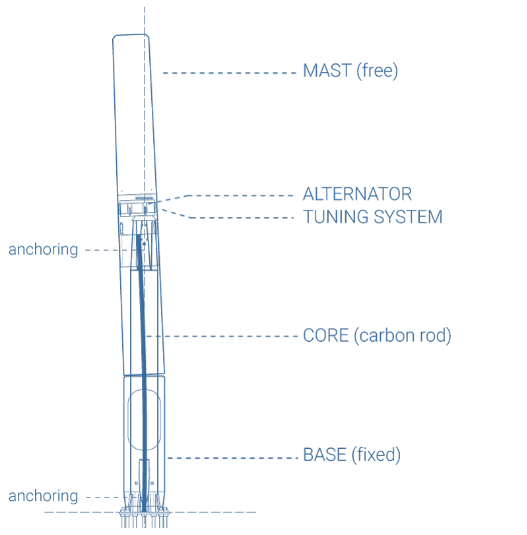Bladeless Wind Generators
A Spanish company is developing wind generators that exploit the vortex-shedding effect. The tapered towers have no rotating parts.

Many years ago, we were living in a new partially-built suburb in a large city on the Canadian Prairies, where we waited at the local bus stop in the winter. The unimpeded strong winds were cold enough to freeze the marrow, but on some days, the tedium was relieved by an unintended physics demonstration.
A fluid moving past a non-streamlined object will form circular eddies (vortices) downstream. These vortices induce a low pressure on the object but they also detach or shed, then a new one forms in the opposite direction, and does the same thing. For any given object this vortex-shedding is regular and continuous at a specific wind speed. All objects, depending on their shape and stiffness of the material they are made from, naturally vibrate at a particular frequency, which is called the resonant frequency (think of a tuning fork or a plucked string). If the object is not mounted sufficiently rigidly and its resonant frequency matches the vortex-shedding frequency, the object will move in harmonic resonance.
Vortices being shed from an object with circular cross-section. (With permission from Vortex Bladeless S.L.)
Vortex Bladeless1 has developed tall, tapered cylindrical towers (which have a somewhat phallic appearance, unfortunately) that oscillate in the wind. A copper coil, connected to the tower, is mounted inside of a stationary annular permanent magnet. The horizontal movement of the tower and coil generates an electrical current. The range of suitable resonant wind speeds is increased by tapering the tower to match wind profiles (wind is stronger higher up), and by the resistance of the coil-magnet set-up, which changes the effective stiffness.

These include no rotating parts for less maintenance, no need for directional or speed control, less land area taken up, no risk to birds, less noise, and likely cheaper to build and operate. Drawbacks include a narrower range of wind speeds it can exploit.
This is a technology worth watching.
Oh, and that bus stop sign? The energy from its vibration was entirely absorbed by the steel of the pole at its base, and it broke from fatigue failure within a year.
Sweet Lightning has no affiliation with any products or manufacturers mentioned in this article.
Reading
- Vortex Bladeless. “Vortex Bladeless | Innovative Wind Power.” Accessed July 3, 2025. https://vortexbladeless.com/.